Site Menu:
| This is an archived Horseadvice.com Discussion. The parent article and menus are available on the navigation menu below: |
| HorseAdvice.com » Diseases of Horses » Lameness » Muscle & Tendon Diseases » Tendon Laxity and Contracture » |
| Discussion on Lax tendons - back on pasterns | |
| Author | Message |
| Member: Imogen |
Posted on Monday, Apr 11, 2005 - 1:32 pm: Dear allThis tall foal was born today and has been vet checked by a specialist horse vet but I wasn't there (at work...). Having read the tendon laxity and contracture article, since the foal can get around, is nursing away and seems very bright the recommendation seems to be keep it in the stable or a small paddock for the first week and it should be OK. However of course to me the deformity looks awful so I would appreciate feedback from others about whether it is in the "normal" range or whether I should be doing anything else... 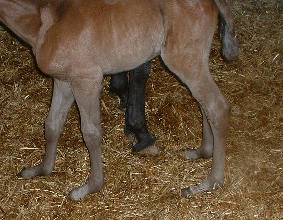 Thanks Imogen |
| Member: Christos |
Posted on Monday, Apr 11, 2005 - 6:49 pm: I knew a colt that was born like this and without much care (they bandaged the legs but I don't think it made a difference) he was much better within a couple of days, perfectly Ok within a week (if I remember well) and grew up to be a formidable racehorse.I do not know, however, if this is within normal range or this colt was just lucky. |
| Member: Imogen |
Posted on Tuesday, Apr 12, 2005 - 1:44 am: Thanks Christos! I also emailed the picture to my farrier (he also breeds racehorses) who says it will be fine too, so now my only worry is that it is an energetic little thing and I hope it doesn't damage itself confined in the stable for a week... It was trying to buck on those legs yesterday at 10 hours old...Imogen |
| Member: Paul303 |
Posted on Tuesday, Apr 12, 2005 - 3:15 am: I saw this also, Imogen, years ago. It was a throughbred colt, born slightly early. He also had one extermely sickle-curved front leg. I remember that he was in support bandages and a foam splint on the front leg....but it was only for a short time. To our amazement, he recovered quickly and completely ( we called him "Pretzel" behind his owner's back ). He went on to quite a career in the Hunter division and was quite a "people" horse - probably due to the extensive hands-on care so early. |
| Moderator: DrO |
Posted on Tuesday, Apr 12, 2005 - 7:33 am: The tendons being too loose or too tight is pretty normal for newborns Imogen and this certainly is not terrible. The important point is to be sure the legs are straight when viewed from the front, continued improvement daily, any increase in swelling is quickly assessed, and protecting the back of the pasterns from abraisons.DrO |
| Member: Eoeo |
Posted on Tuesday, Apr 12, 2005 - 8:12 am: We had a foal that was orphaned at 36 hours. We went through 3 nurse mares and have finally got him on one after 3 weeks. During this time, he has been severely down on his pasterns. He has very bad abrasions. We have a hard time keeping his heels wrapped.He is 3 weeks old but actually is like a colt that is a week or week and a half old after all he has been through. Is penis just DrOpped down at three weeks when normally they are they DrOp at a few days. His pasterns are slowly coming up but his left hind leg is a little weak. We have kept him in a 20 by 20 stall so far. We are taking them to the round pen every coupple of days. Is more exercise called for at this point? EO |
| Member: Mrose |
Posted on Tuesday, Apr 12, 2005 - 10:33 am: I was told that exercise helps these little guys strengthen their pasterns. But, down at the pasterns, as Dr. O. said, is much different than a crooked leg. I think they need splinting and rest. I think this happens on foals that are a little early and maybe those with really long pasterns. All the ones I've seen straighten up nicely. |
| Member: Imogen |
Posted on Tuesday, Apr 12, 2005 - 5:06 pm: The foal has improved already after a day especially the hind legs. It is being kept in a well-strawed stable and is now "up" enough that I don't think abrasions are too much of a risk. It is very friendly and already enjoys a scratch, but I felt it was unwise to try feeling its rear fetlocks this evening without another person around to restrain it!In fact the main problem is it is very energetic and keeps trying to gallop around mum in the stable... and everyone is telling me it is to be kept in until Sunday at least! I am not looking forward to taking it home tomorrow night but I have the horsebox well-strawed too and it is only about 12 miles. I find they often lie down when travelling anyway. Its legs look reasonably straight otherwise but it won't stay still long enough to get a really good look at the right fore which might be slightly splayed outwards below the pastern, I'm going to keep an eye on that. There is no swelling. Thanks everyone for the feedback, much appreciated. Imogen |
| Member: Eoeo |
Posted on Tuesday, Apr 12, 2005 - 11:37 pm: We have his abrasions on the orphan bandaged pretty well. Would it be better to tape up the pasterns past the ankles, Dr. O, to give him some support or better to leave them alone? EO |
| Moderator: DrO |
Posted on Wednesday, Apr 13, 2005 - 6:30 am: It will depend LKR, the more support you give the slower the improvement will be. The exception is if the laxity is causing excessive uneven stress across the joint. You will see this mainly if there is a lot of side to side laxity (angular deformity) in the joints. For more exact recommendations see the article associated with this forum and follow the link to the article on angular deformities.DrO |
| Member: Chohler |
Posted on Wednesday, Apr 13, 2005 - 3:48 pm: Imogen I have seen this alot in mustang foals who's mothers are on the range or just came in off the range. They all were normal within a week or to. Taller foals more than small ones.I have always made sure i supplied the mare with a high quality supplement. I use equivitaphos? Spelling? I have only seen one really bad case and we used door hinges and duct tape to correct the foal. But it was SEVERE. Your baby is cute and just fine. What you see that you say is awful looks ok. With plenty of excersize you will notice a difference shortly. Nice baby I envy you no babies for me this year. |
| Member: Imogen |
Posted on Saturday, Apr 16, 2005 - 10:04 am: Hi again everyone. Here is the foal at 6 days (ie 5 days after the other picture in this thread):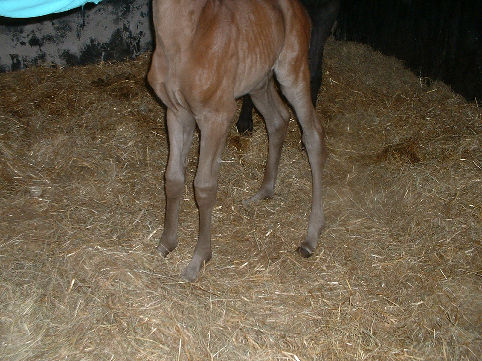 It has come up quite a bit, but I still think it looks pretty awful and it is walking on its hind heels a bit (you can see the toe is just off the ground though perhaps not too clearly in this picture, let alone its ghastly knock knees and hocks - can't see me showing this one!). I had to put it out today because it was (literally) banging its head off the walls of the stable trying to gallop around in there and had already grazed a knee and a hock. It gets around absolutely fine (and learned how to do flying changes and what an electric fence was within 5 minutes of being put in the pasture...) so I think the best compromise is out during the day and in at night for a while. My vet says if it doesn't improve they can put aluminium extensions (?) on its hooves but he thinks just a bit more time should do it. All the best Imogen |
| Moderator: DrO |
Posted on Saturday, Apr 16, 2005 - 10:57 am: Your superficial flexor has really improved but the deep stil has a way to go but agree with your vet. Things should move quicker now that the foal is out. I would watch those heels closely, they may need protection. A little cotton and vetwrap should do it.DrO |
| Member: Imogen |
Posted on Friday, Apr 22, 2005 - 5:39 am: This foal now 11 days old is still slightly walking on its heels at the back although it has improved since the last picture. I asked my farrier when he wants to see it, he said not until it is 3-4 weeks old.Dr O, would that be the same timescale for the vet? wait 3-4 weeks for nature to fix it before interfering? What I don't like is it is wearing its rear hooves at the back although it has no ulcers or anything like that. Thanks, I did ask my vet this last week but didn't get a clear reply due to the usual large queue of boxes in their yard on a Saturday morning. Imogen |
| Moderator: DrO |
Posted on Friday, Apr 22, 2005 - 6:12 am: As long as there is continued improvement I am uncertain what the vet would do Imogen. Continue to provide the foal with all the exercise that is prudent and if you are getting heel wear, increase the heel protection, you do not want him to get sore back there.DrO |
| Member: Imogen |
Posted on Friday, Apr 22, 2005 - 3:05 pm: Thanks!It is a very quiet animal in the stable so I have been checking its hind heels and pasterns for any soreness every morning while it's having a little lie down after breakfast, before I put them out in the field. I have been surprised that it is not showing any signs of soreness but the weather is wet here and the ground well covered with grass, so the surface is nice and soft. Mostly it just moseys about giving weeds a hard time and pretending to graze, apart from the usual foal fits of silliness, so I have not tried to restrict its exercise - they are in a section of the field of about 1.5 acres. Just wanted you to know that I have taken good note of your warnings and am keeping an eye out! All the best Imogen |
| Member: Imogen |
Posted on Monday, May 2, 2005 - 9:34 am: This is the same foal at 3 weeks for anyone else who encounters a similar problem - not a great picture as it would only stand still in the muddiest corner of the field!It has improved again but still isn't quite right in the hind legs although it actually moves very nicely, and strangely enough has a super trot.  It is tall and growing extremely fast (already having trouble getting underneath mum for the milkbar). Fingers crossed it will eventually sort itself out otherwise I may have to call it Tarantula! All the best Imogen |
| Member: Dyduroc |
Posted on Tuesday, May 3, 2005 - 6:28 am: Imogen, what a difference! I hope he continues to improve.dyd |
| Moderator: DrO |
Posted on Tuesday, May 3, 2005 - 6:35 am: Maybe I need my glasses Imogen but the back legs look fine to me!DrO |
| Member: Imogen |
Posted on Tuesday, May 3, 2005 - 9:57 am: Yup, looks ok in this picture Dr O, but the right hind still sort of flips into a toe-up position some of the time. I'm hoping plenty of bouncing about in the field will strengthen it enough to fix it permanently! Anyway I thought this latest pic would cheer up anyone else who found they had one of these. thanks all for your reassuring posts during the past 3 weeks.Imogen |
| Member: Imogen |
Posted on Friday, Jul 29, 2005 - 2:41 am: Hello all. An update. This foal is now 3.5 months old, and starting to come on well with a good temperament but... there is something weird about its right hind.Sometimes the toe flips upwards as though the pastern were double jointed. I might see this when I am checking the horses maybe once or twice a week though I think it is improving. I took it to the specialist horse vet yesterday, he says there is "nothing to be done" and he is "happy with it" by which I am not sure if I am being a worrywort or whether it's got a problem which can't be fixed. In fairness when we trotted the foal up the foot didn't do it for him but he looked at it and felt the joint (he was under a lot of time pressure due to assistants on holiday). Here's a picture of it with the foot in "normal" position, since it only does it occasionally when moving it is hard to catch on camera! I just wondered if anyone had seen anything like this before? My farrier says he thinks it is just a bit of weakness left over from the lax tendons which should be ok in time, and at least the hoof is wearing evenly both sides so any movement is up and down not side to side. 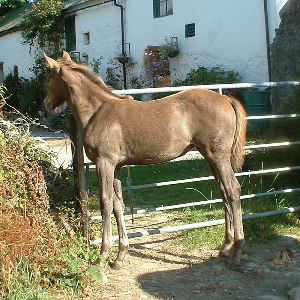
|
| Moderator: DrO |
Posted on Friday, Jul 29, 2005 - 9:37 am: Though I cannot see the toe flipped up above, I do see fairly normal hoof/pastern angles in the picture above. From your description I agree with your farriers assessment Imogen and it sounds like this is what the vet was saying too.DrO |
| Member: Imogen |
Posted on Friday, Jul 29, 2005 - 12:06 pm: Thanks, I'll stop worrying for a while! If I manage to get a good pic of the toe flipped up (it does look very strange) I'll post it.Imogen |
| Member: Chohler |
Posted on Friday, Jul 29, 2005 - 2:09 pm: Imogen I had a gelding that would do the weird toe flip like he was double jointed, it happend after a bad dog attack and he got cut up real bad. The vet said it was just from weakness and that it would get better with time, he had countless stitches and had to wear a cast for a month. It took 7 months to be exact but he is stronger and not doing this anymore. Not that this is the same thing but it does get better with time. |
| Member: Quailcrk |
Posted on Wednesday, May 24, 2006 - 7:17 pm: I had a foal born 6 days ago with very lax tendons in the rear legs and very wind swept especially with the right rear leg. He is getting better each day, very strong, very active, bright etc. Gets up and down very well. We are watching the front legs one is a bit turned at the knee turning out, but also seems to be getting straighter daily.Wondered if there is any knowledge as to what causes this? Had another 3 years ago and she straightened out in a couple of weeks with limited turn out. |
| Moderator: DrO |
Posted on Thursday, May 25, 2006 - 8:45 am: I think the question ought to be why does this not happen more often Joan. Consider the problem of growing a foal in a uterus so that when it comes out it is able to stand well within minutes of being born. That the tendons are usually a bit loose or tight is not surprising. Why some are worse than others is probably just the range of normal for growing a fetus who can stand.The real sad ones that are unable to stand or not functional enough to make it may well have had some identifiable adverse event but other than prematurity and foal diseases that cause weakness and perhaps some toxins we don't know what that is yet. DrO |
| Member: Quailcrk |
Posted on Thursday, May 25, 2006 - 9:31 am: Thanks Dr O, I guess I was looking for a preventative measure and hoped to avoid future problems if possible. You make a good point, as they are a miracle in themselves after only 11 months growing time. |
| Moderator: DrO |
Posted on Friday, May 26, 2006 - 10:02 am: Good care of the pregnant mare is your number one preventive measure. Concerning the proper growth of the fetus pay particular attention to the quality of the forage and the condition of the mare. For more see our article on pregnant mare care.DrO |
| Member: Imogen |
Posted on Wednesday, May 31, 2006 - 8:41 am: Hi JoanThis is the foal pictured at the beginning of this thread at just over one year. Although she DOES have very long rather upright pasterns she has shown no ill effects from being born with lax tendons. Imogen 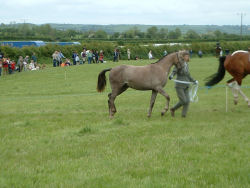
|
| Member: Imogen |
Posted on Wednesday, May 31, 2006 - 8:42 am: By the way folks, just what you need when you are showing a yearling in hand - the nextdoor arena was full of a ridden hunter coloured horses GALLOPING past... |
| Member: Canter |
Posted on Wednesday, May 31, 2006 - 1:25 pm: Imogen, it looks like your yearling handled herself very well despite the distractions. I wish the picture was closer so we could see her better, but I'm so glad that she's grown out of the lax tendons. Is she starting to turn gray or is it just the lighting? |
| Member: imogen |
Posted on Wednesday, Jun 24, 2009 - 5:54 pm: Just thought I would update this thread to cheer up anyone whose foal has lax tendons... This is the same animal at four years old attending the BHS summer camp and doing a cross country lesson. One of instructors wanted to buy her... the other one told me to stop riding her "like a wagon!"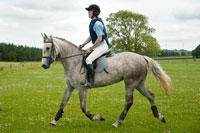
|
| Member: imogen |
Posted on Wednesday, Jun 24, 2009 - 5:56 pm: Don't know why but it won't let me upload more thanone picture at once...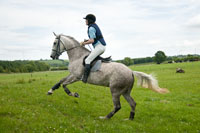 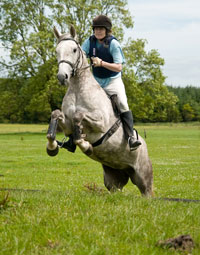
|
| Member: imogen |
Posted on Wednesday, Jun 24, 2009 - 5:58 pm: 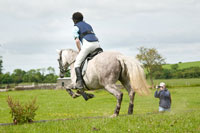 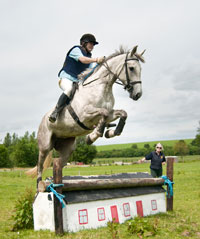 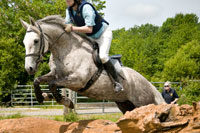
|
| Member: rtrotter |
Posted on Wednesday, Jun 24, 2009 - 6:39 pm: Imogene,I only have one question. How did this mare go from chestnut with a white blaze to totally grey? She looks great. I have one that looked exactly the same, my husband thought he was deformed. He is now 14 months old and stands great. I've been working with him for the last month and he is doing great. I had his mother and brother and neither one of them showed the same level of maturity that this young fella does at 14 months old. Good luck with her Rachelle |
| Member: mrose |
Posted on Wednesday, Jun 24, 2009 - 6:54 pm: Beautiful horse, Imogene! My only question is, what did the trainer mean by "riding like a wagon?" That's a term I've never heard before. That's a term I've never heard before.
|
| Member: leslie1 |
Posted on Wednesday, Jun 24, 2009 - 8:41 pm: ImogenWow! She looks great from every angle! Looks like fun! L |
| Member: imogen |
Posted on Thursday, Jun 25, 2009 - 3:00 am: "Wagon" - A difficult or awkward woman "she's a right wagon"; ugly woman. Generally of overweight middle-aged females with loud opinions!Rl - grey horses are usually born the colour they would have been if they weren't grey, then they gradually go grey. This mare's sire, Grange Bouncer, has the double-grey gene so all his offspring are grey. Thanks for the kind comments about the horse. The dam is in foal to Grange Bouncer again so fingers crossed... Imogen |
| Moderator: DrO |
Posted on Thursday, Jun 25, 2009 - 4:05 am: This should relieve a lot of folks concerns Imogen, thanks for the update and wonderful looking horse.DrO |
| Member: mrose |
Posted on Thursday, Jun 25, 2009 - 10:54 am: Where would I have met your trainer, Imogene? She is beautiful! So very athletic looking for a horse her age. I'm also impressed with your being on her! From one "old wagon" to another, you look great! |
| New Member: peggymc |
Posted on Wednesday, Jun 2, 2010 - 9:51 pm: I wish I had seen Dr. O's article and advice for my baby foal several weeks ago. He had lax tendons, and was put out without bandages because I wasn't told sores would quickly develop. He wound up with septic arthritis, which did not respond to antibiotics and was put down today. By the time I learned about Elasticon, which worked great, he already was starting toward open sores. Please take Dr. O's advice, bandage even if the foal is in the stall. Watch your foal when turned out to be sure the bandages are holding. If you put vet wrap under the Elasticon, which is very sticky, it will be much easier to take the Elasticon off without tearing at your foal's hair and skin. |
is The Horseman's Advisor
Helping Thousands of Equestrians, Farriers, and Veterinarians Every Day
All rights reserved, © 1997 -
